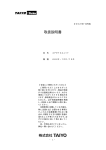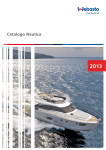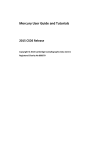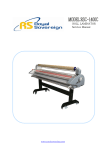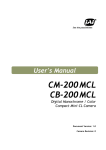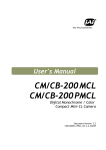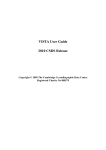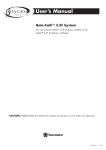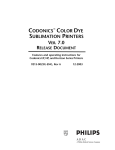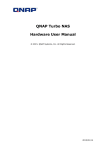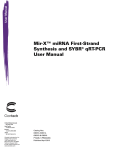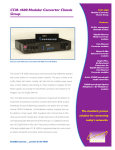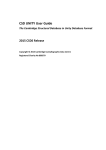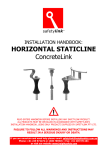Download the User Manual for the IVB 1000 Chamber, in PDF Format
Transcript
SeeDOS User Manual IVB 1000 Ionization Chamber Table of Contents General Precautions ...................................................... 2 Features and Specifications .......................................... 3 General Procedures for Medical Measurements ........... 4 Overview ...................................................................... 6 Calibration of IVB 1000 ............................................... 8 Constancy Check of IVB 1000 ..................................... 8 Operation ...................................................................... 9 90 Procedures for Calibration of IVB Sr sources .......... 11 192 Procedures for Calibration of IVB Ir sources ......... 13 Procedures for Other Source Holders ......................... 16 Maintenance................................................................ 25 Service ........................................................................ 25 Brachytherapy Parts List ............................................ 26 Bibliography; Brachytherapy Measurements ............. 27 Customer Responsibility ............................................ 28 Warranty ..................................................................... 29 © 2002 Standard Imaging Inc. 7601 Murphy Drive Distributed Middleton, WI 53562 by SeeDOS Phone:Ltd (608) 831-0025 Fax: (608) 831-2202 Please contact [email protected] General Precautions Warnings and Cautions alert users to dangerous conditions that can occur if instructions in the manual are not obeyed. Warnings are conditions that can cause injury to the operator, while Cautions can cause damage to the equipment. WARNING: Electrical shock hazard when connected to 300 V bias supply. Do not remove cover. CAUTION: Proper use of this device depends on careful reading of all instructions and labels. CAUTION: This device should never be submerged to clean or scrubbed with an abrasive cleaner. CAUTION: Do not drop, mishandle, or disassemble unit since it may result in change of calibration factor. Refer all servicing to qualified individuals. CAUTION: Do not sharply bend triax cable. Damage to the cable may result in high leakage currents. CAUTION: Insure source freely moves within secured catheter. Proper location of source is necessary to assure proper calibration. – 2– Features and Specifications Active Volume 475 cm3 ADCL Calibrations Various single seed, 90Sr/90Y beta Isotope Source Holders...... Iridium IVB Source Holder, REF 70034 Strontium IVB Source Holder, REF 70036 X-Ray Contamination Test Tool, REF 70042 IVB Single Seed LDR Source Holder, REF 70043 IVB HDR Source Holder, REF 70044 IVB Cesium 5mm Source Holder, REF 70045 IVB Cesium 7mm Source Holder, REF 70046 Mick® Source Holder, REF 70047 Seed Strand Source Holder, REF 70048 IBt InterStrand® Source Holder, REF 70049 Imagyn isosleeve™ Source Holder, REF 70050 Connector Cable Bias Voltage Applied Leakage Stability Response Sensitivity Aion Case Dimensions Height Diameter Insert Diameter Insert Height Weight Two lug triax (standard), TNC, or Type M 1 meter (3 feet) ±300 volts, typical Less than 50 fA 0.2% (Reproducibility ) ± 0.3% over 100mm at center of axis, typical 2.4 pA/U typ for 192Ir 38.5 nA/Gy/s typ for 90Sr 1.000 Rugged carrying case 25.9 cm (10.2 in.) 10.2 cm (4.0 in.) 3.5 cm (1.4 in.) 22.4 cm (8.8 in.) 3.6 kg (8.0 lbs) –3– General Procedures for Medical Measurements The following procedures should be used any time that measurements are to be made with an ionization chamber and electrometer system. This applies only to the setup of the ionization chamber and electrometer, not to the setup of the ionization source. 1. With nothing connected to the input jack of the electrometer, turn the power on and wait at least 15 minutes for warm up. 2. Verify the leakage of the electrometer is within the manufacturer’s stated acceptable limits. 3. Connect the ionization chamber to the electrometer and apply 100% voltage bias. 4. Allow the electrometer and the ionization chamber system at least 10 minutes to stabilize,making certain that all cabling is lying flat and unkinked. 5. Verify the leakage of the ionization chamber is within the manufacturer’s stated acceptable limits. If measured in the presence of background sources, note that this signal will add to the leakage of the chamber. 6. Some electrometers, such as the Standard Imaging MAX-4000 Electrometer, allow the user to zero the device at any time. If desired, perform this system zeroing now. 7. Check the system leakage. Take a reading without exposing the chamber to radiation. This reading should be less than 0.1% of the final signal expected. If it is not, the leakage should be subtracted from the signal. – 4– 8. Measure the atmospheric temperature and pressure. For well chambers, measure the temperature in the well of the chamber. 9. Turn on or insert the radiation source(s) and take at least 3 measurements. Generally the measurements should not be moving in only one direction (i.e. three readings that continue to drop and hence may not yet be stabilized). If a current measurement is done, allow sufficient time for value to stabilize. 10. Analyze the data taking into account the average of the readings, system leakage, temperature/pressure corrections, calibration factors and any other appropriate corrections to be made. Keep in mind that the calibration factor consists of the electrometer calibration factor and the ionization chamber calibration factor. 11. When all measurements are completed, set bias voltage to 0VDC, turn off the electrometer and disconnect the ionization chamber. –5– Overview The Standard Imaging IVB 1000 Ionization chamber is a well-type ionization chamber. It is specifically designed for measurement of Intravascular brachytherapy sources, with the appropriate calibration. It is recommended that the chamber be calibrated every two years as is standard practice for other ionization chambers. Initially, the calibration factor is given in the calibration report from the Accredited Dosimetry Calibration Laboratory (ADCL). The appendix provided with the calibration report discusses the calibration factors in greater detail. Calibration factors should be obtained from an ADCL for each brachytherapy source that is being measured. The ionization current expected from the IVB 1000 is approximately 2.4 pA/U for 192Ir brachytherapy sources and 38.6 nA/Gy/s for 90Sr. U is the unit for air kerma strength and is µGym2h-1. Thus, the measurement of all brachytherapy sources requires an electrometer with a calibrated scale for measuring currents in the range from pA to nA. Alternatively, a calibrated charge scale may be used with timed runs. Calibration of all brachytherapy sources with ionization chambers is important. When a brachytherapy source is used, it is imperative that there be an accurate and reliable calibration of the source strength by means of a suitable chamber, such as the IVB 1000. Using other inserts, low dose rate brachytherapy seeds can also be calibrated with the IVB 1000. Use the appropriate insert for a given source. Additionally, do not confuse details in one section of this manual with those of another. Some details are specific only for the given application or radionuclide. – 6- The half life of 192Ir is 73.83 days. The manufacturer for intravascular applications recommends monthly source replacements to maintain the correct output level. The half life of 90Sr is 28 years. However, the manufacturer recommends 250 uses or replacement on a six month basis. All of these sources must be calibrated when placed in use and may be checked periodically during use. Suppliers of sources usually provide calibration certificates that can have an uncertainty of ±4% or more, necessitating an independent calibration for better accuracy. This point is addressed in the article published in Brachytherapy Dosimetric Assessment: Source Calibration,RSNA Categorical Course in Brachytherapy Physics 1997, pp. 143-153. The IVB 1000 is convenient for frequent use. If your measurement differs significantly from the manufacturer, you should resolve the difference before use. Please note that the factors that are used in the calibration of these chambers are the most current, and in some cases, may be different than those used in treatment planning computers. This difference, if present, should be accounted for during your treatment planning activities. To avoid confusion, the American Association of Physicists in Medicine has recommended that air kerma strength calibrations be used for gamma emitting brachytherapy sources (AAPM Reports No. 56, 60, 40 and 32) instead of source activity. Because of the difficulty of beta calibrations using an extrapolation chamber both the absorbed dose at 2mm in water and contained activity are presently in use. It is desired that only the absorbed dose at 2mm will be used in the future. The only NIST traceable calibration quantity is air kerma strength for gamma rays and this is the calibration factor provided for the IVB 1000. Any other quantity desired, for example, apparent activity, will have to be derived using agreed upon constants. Further details are provided in the appendix included with the calibration report. – 7– Calibration of IVB 1000 As is standard practice for other ion chambers, it is recommended that the IVB 1000 be calibrated every 2 years. It should be calibrated with the source insert used for the chamber. This calibration should be performed by an Accredited Dosimetry Calibration Laboratory. Standard Imaging offers calibrations from the University of Wisconsin Accredited Dosimetry Calibration Laboratory. You need only one purchase order to cover calibrations, shipping and handling, and service. Standard Imaging hand carries all instruments to and from the ADCL. Constancy Check of IVB 1000 Regular constancy checks should be performed by using a procedure such as the following. The source holder may be removed to allow the stability of the IVB 1000 to be checked by means of a constancy check source, e.g. using a low dose rate 137Cs brachytherapy source with the insert in place. Alternatively, the stability can be monitored with the use of an external 60Co beam. This value should be obtained upon receipt of the chamber and monitored for consistency thereafter. Either place the chamber in the 60Co beam at a known distance with a standard field, such as 10 cm x 10 cm, or place the 137Cs source in a reproducible position and take a current reading. A graph of the response corrected for decay should remain within +/-0.5%. – 8– Operation The IVB 1000 ionization chamber has a vent hole to maintain the internal air at ambient atmospheric pressure. Thus, the readings obtained must be corrected for ambient temperature and pressure to the temperature and pressure of calibration (22o C and 760 mm Hg) at “normal” relative humidity (50% ± 25% non-condensing) in the usual accepted manner. The IVB 1000 has variable inserts available that can be set for different seed lengths. Figure 1A shows the 192 Ir insert and Figure 1B shows the 90Sr insert. Figure 2 shows a typical axial response curve for the IVB 1000 as determined by a single 192Ir source. There is only a +0.3% variability in sensitivity within 100 mm around the center (50 mm on each side). The axial response curve is similar for the 90Sr source. The IVB 1000 utilizes a conventional triax connector and cable to be connected to a suitable electrometer. A bias of 300 volts must be applied to the electrometer lowimpedance connection relative to chassis ground such that the guard of the ionization chamber is at this voltage relative to ground. The voltage polarity effect is less than 0.1%. If desired, a second bias level of 150 volts can also be used to determine the ionic recombination loss at 300 V. 1 The ionic recombination loss is less than 0.05% and thus can be considered negligible or equal to a correction of 1.000. 1 The equation used is A ion = 4/3 - (Q1/3Q2), where Q1 is the charge or current measured at 300 V and Q2 is the charge or current measured at 150 V. See Med. Phys. 11: 714 (1984). –9– Figure 1A: REF 70034, Source Holder for Iridium IVB seed trains. Markings show the number of seeds in the train: 6, 10, 14, 18 or 22. As shown above, the Source Holder is set for a seed train with 10 seeds (the lowest number visible on the sliding portion of the Holder). Figure 1B: REF 70036, Source Holder for Strontium IVB source trains. Markings show the length of source in cm. As shown above, the Source Holder is set for 30 cm (the lowest number visible on the sliding portion of the Holder). – 10– Figure 2: Typical axial response shown as a percent with distance from the bottom of the chamber. The step by step procedure for measurement of intravascular brachytherapy sources follows. If measuring 192Ir, the chamber can be left with the lead rings on it at all times. Generally the chamber is calibrated with the lead rings on it. If the chamber was calibrated without the lead rings, it should be used in that manner. DO NOT use lead rings when calibrating 90Sr seed trains. NOTE: There is a 1% difference in calibration factor whether or not the lead rings are present since the lead rings contribute scatter into the chamber. Procedures for calibration of IVB 90Sr sources REF 70036, Strontium IVB Source Holder for 90Sr sources 1. If necessary, let the IVB 1000 Chamber equilibrate to ambient temperature and pressure for at least 30 minutes before the measurement. 90 WARNING: NEVER cut the catheter for Sr source trains (manufactured by Novoste). – 11– 2. Connect the IVB 1000 Chamber to a suitable electrometer, such as the MAX 4000 from Standard Imaging, and apply 300 V bias voltage. Allow the system to stabilize for at least 10 minutes. Be sure to use the bias voltage with which the IVB 1000 was calibrated. 3. Set the Source Holder to the length of source to be measured: 30, 40 or 60mm. This is indicated by the lowest number visible on the Source Holder. See Figure 1B. Insert the Source Holder into the IVB 1000. 4. Carefully slide the Source Catheter into the top opening in the knurled knob on the Source Holder. Insert the Catheter until it bottoms, about 7.5” deep. 5. Secure the Source Catheter by tightening the Knurled Knob until the Catheter no longer moves up and down easily. Do not tighten too far so the source is unable to pass completely into the Source Holder, or that the catheter is kinked or damaged. 6. After performing all manufacture recommended safety procedures for the IVB seed train, run the seed train to the bottom of the Calibration Catheter (Verify again that the setting on the Source Holder matches the number of seeds in the train). Let the reading stabilize for a minimum of 20 sec for current measurement or for a reproducible set time for charge measurement. 7. Read and record the measured current or charge at five positions (e.g. rotate the Source Holder in the Well chamber to the compass positions of 0°, 90°, 180°, 270°, and 360° for succesive measurments). Take the average of the readings. 8. Use correction factors for temperature/pressure, electrometer correction factor (electrometer must be calibrated) and calibration factor for the IVB 1000 given – 12– by the Accredited Dosimetry Calibration Laboratory to calculate the absorbed dose rate at 2mm for the source. The following equation can be used Dw = R * F * E * C where: Dw = the absorbed dose rate at 2mm depth in water R = the reading in A (if current scale) or in C/s (if charge scale measured for a set time in s) F = the temperature and pressure correction factor E = the correction factor for the electrometer scale C = the IVB 1000 calibration factor Note: “Dw” can be divided by Aion if desired to correct for recombination effects. Since the IVB 1000 has an Aion of 1.000, this is not necessary. The value of Dw will give the total absorbed dose rate at 2mm for the source length measured. For example, if R = 6.220 n A, F = 1.009, E = 0.999 and C = 42 Gy/s/nA, then Dw=(6.220nA) * (1.009) * (0.999) * (42Gy/s/nA) = 263Gy/s Note: A calibration factor is also given for contained activity. The equation above is still used with C being replaced by the calibration factor for contained activity. The result obtained is then the “contained activity” instead of Dw. Procedures for calibration of IVB 192Ir sources REF 70034, Iridium IVB Source Holder for LDR seeds 1. 192 Convert a Treatment Catheter to a Calibration Catheter if required. 192 WARNING: This is only applicable for IVB Ir sources and only if a Calibration Catheter has not been provided or fabricated. – 13– Ir Figure 3: Converting a Treatment Catheter to a Calibration Catheter for 192Ir IVB sources Using a sharp exact-o knife, cut off the blue tip of a 192 Ir treatment catheter as shown in Figure 3. Retain this Calibration catheter and use with all future source calibrations. 192 Warning: This procedure is only for IVB Ir sources. 2. 3. 4. 5. Place the IVB 1000 Chamber with the lead rings around it as calibrated. If necessary let the chamber stabilize for at least 30 minutes before the measurement to allow it to equilibrate to ambient temperature and pressure. Connect the IVB 1000 Chamber to a suitable electrometer, such as the MAX-4000 from Standard Imaging, and apply 300 V bias voltage. Allow the system to stabilize for at least 10 minutes. Set the Source Holder to the number of seeds to be measured: 6, 10, 14, 18 or 22. This is indicated by the lowest number visible on the Source Holder. See Figure 1A. Insert the Source Holder into the IVB 1000. Carefully slide the blue-tipped end of the Calibration Catheter into the top opening in the knurled knob on the Source Holder. Insert the Catheter until it bottoms within the Source Holder (about 7.5”). – 14– 6. 7. Secure the Calibration Catheter by tightening the Knurled Knob until the Catheter no longer moves up and down easily. Do not tighten too far so the IVB seed train is unable to pass completely into the Source Holder. After performing all manufacturer recommended safety procedures for the IVB seed train, run the seed train to the bottom of the Calibration Catheter (Verify again that the setting on the Source Holder matches the number of seeds in the train). Let the reading stabilize for a minimum of 20 sec for current measurement or for a reproducible set time for charge measurement. 8. Read and record the measured current or charge. 9. Use correction factors for temperature/pressure, electrometer correction factor (electrometer must be calibrated) and calibration factor for the IVB 1000 given by the Accredited Dosimetry Calibration Laboratory to calculate the air kerma strength of the source. The following equation can be used Sk = R * F * E * C where: Sk = the air kerma strength of the source R = the reading in A (if current scale) or in C/s (if charge scale measured for a set time in s) F = the temperature and pressure correction factor E = the correction factor for the electrometer scale C = the IVB 1000 calibration factor for air kerma strength Note: “Sk” can be divided by Aion if desired to correct for recombination effects. Since the IVB 1000 has an Aion of 1.000, this is not necessary. The value of Sk will give the total air kerma strength for the number of seeds measured within +0.3%. For example, if R = 6.220 n A, F = 1.009, E = 0.999 and C = 421 U/nA, then – 15– Sk = (6.220nA) * (1.009) * (0.999) * (421U/nA) = 2640 U If the value of air kerma strength is for a number of seeds and the individual value of each seed is desired, divide the value by the number of seeds in the train. The value for absorbed dose rate at 2mm is determined using AAPM task group 60 report. Procedures for Other Source Holders REF 70042, X-Ray Contamination Test Tool This tool is designed for use with 90Sr sources only. It consists of a 7mm radius of material that absorbs nearly all of the beta particles. Thus, it allows only the x-rays created in the encapsulation of the seeds to be detected. 1. 2. 3. 4. 5. 6. After the calibration measurement of a 90Sr source train with the Strontium source holder, REF 70036, loosen the knurled knob and remove the calibration catheter and source holder from the IVB 1000. Place the X-Ray Contamination Test Tool into the IVB 1000. Slide the catheter into the opening in the knurled knob on the source holder and insert it until it bottoms within the source holder. Secure the catheter by tightening the knurled knob until the catheter no longer moves up and down easily. Do not tighten too far so the seed train is unable to pass completely into the source holder. Inject the source, following the source manufacturer’s instructions. Read and record the measured current or charge. Calculate the ratio of this reading with the calibration reading taken with the Strontium source holder, REF 70036. A representative value is 2.76 x 10-3 + 0.5%. – 16– REF 70043, IVB Single Seed Source Holder 1. 2. Insert an individual seed into the center tube of the source holder. The source holder will place the seed at the most active area of the chamber. Take a measurement. A seed can be removed by removing the source holder and inverting. The center tube will allow the seed to easily slide out. ADCL calibrations are available for LDR iridium, iodine and palladium seeds. ADCL calibrations are not available for gold. REF 70044, IVB HDR Source Holder 1. 2. 3. 4. 5. 6. Place the IVB 1000 Ionization chamber in the same room as the HDR unit for at least 30 minutes before the measurement to allow it to equilibrate to ambient temperature and pressure. Connect the IVB 1000 Ionization chamber to a suitable electrometer, such as the MAX-4000 from Standard Imaging, and apply 300 V bias voltage. Allow the system to stabilize for at least 10 min. Connect a catheter, such as the endobronchial, French 6 blue catheter to HDR irradiator. Align the black dot on the well insert with the punch mark on the body of the chamber. Insert catheter end to bottom of source holder. The dead space at the catheter end must be known, so 192 that the center of the Ir source can be positioned at the most sensitive spot of the chamber. See Figure 2, page 11 for a typical axial response curve for the IVB. Use the point determined during calibration as the sensitive spot for the IVB 1000. Secure the catheter by tightening the knurled knob, until the catheter no longer moves up and down easily. Do not tighten too far so the HDR source is unable to pass completely into the Source Holder. – 17– 7. After performing all manufacturer recommended safety procedures for the HDR after-loading device, 192 run the Ir source to the radiation sensitive axial point of the chamber for a minimum of 20 sec for current measurement or for a reproducible set time for charge measurement. If the charge mode is used and the charge is accumulated while the source is in transit, account for the transit time error of the source by making the standard timer end effect measurements as described in High Dose Rate Brachytherapy: A Textbook, Nag, ed. Futura, 1994. Note: This value will differ depending on the length of the catheter. The timer feature of Standard Imaging electrometers can be used to collect charge for set times and eliminate this effect. REF 70045, IVB Cesium 5mm Source Holder 137 For Cs calibrations, verify the plastic spacer inside the source holder insert is at the bottom of the source holder. Insert the cesium source into the source holder using safe handling procedures. Take measurements using the method described in the “General Procedures for Medical Measurements” Section of this manual. See Figure 4. – 18– REF 70046, IVB Cesium 7mm Source Holder Insert the cesium source into the source holder using safe handling procedures. Take measurements using the method described in the “General Procedures for Medical Measurements” Section of this manual. See Figure 5. Figure 5: REF 70046 REF 70047, MICK® Source Holder for IVB 1000 This source holder allows for a constancy QA check of seeds loaded into a MICK cartridge. Screw a loaded cartridge into the holder from the bottom as shown and make sure the seeds are not blocked by the metal posts. This holder is to be used only in the IVB 1000, and is marked “For use in the IVB1000 only” on the top label. For measurement in the HDR 1000 Plus Well chamber, use Source Holder REF Figure 6: REF 70047 70023. See Figure 6. REF 70048, Seed Strand Source Holder This source holder is designed for QA measurements of RAPID Strand 6711 Iodine seed strands prior to use, and is designed for use only with the IVB 1000 Well Chamber. A RAPID Strand containing 10 iodine seeds was evaluated with the IVB 1000 and the Seed Strand Source Holder. Following the evaluation, seeds of the RAPID Strand were cut from the strand. The collective seed measurements were compared with individual seed measurements in the Single Seed Source Holder, REF 70043, to obtain a correction factor. This factor was found to be approximately 1.07 times the 6711 Iodine seed calibration factor from the University of Wisconsin Accredited Dosimetry Calibration Laboratory. – 19– The results of the above testing apply specifically to the submitted strand type and well chamber. Application of these results to any well chamber and its associated holder may result in errors due to differences in manufacturing processes, component composition, and the effects of different stranded seed trains to those variations. It is recommended that this investigation be repeated by users upon initial receipt of this holder to verify this number. The Seed Strand Source Holder, REF 70048, can be gas sterilized or steam sterilized (autoclaved). To measure a RAPID Strand source, raise the lift knob on the top of the source holder as far as possible, and insert the strand in its amber-colored spacing jig. There is a plastic key on the bottom of the housing to guide the spacing jig so the seeds are in the center of the well chamber. Lower the lift knob, and measured activity of all ten seeds in the strand. Inverting the RAPID Strand is not necessary. To measure more Rapid Strand sources, simply raise the lift knob, and remove the measured RAPID Strand from the holder. A formula can be used to determine the average seed air kerma strength (AKS) as a QA measurement of the sum of 10 seeds. Average seed air kerma strength= R * CF * CT/P * EF N R = reading CF(correction factor) = ~ 1.07 times the ADCL iodine calibration factor for Amersham 6711 seeds, obtained with Single Seed Source Holder, REF 70043 N = number of seeds CT/P = correction for temperature and pressure EF = electrometer correction factor – 20– For Example: You receive a strand with an average air kerma strength of 2 -1 0.3µGym h per seed. Ten seeds are measured, and an io11 2 -1 -1 dine calibration factor of 2.6 x 10 µGym h A is used. Assume: -11 R = 0.9914 x 10 A N = 10 11 CF = (1.07) (2.6 x 10 ) C = 1.014 T/P EF = 0.998 Average seed air kerma strength = -11 11 (0.9914 x 10 A) (1.07) (2.6 x 10 ) (1.014) (0.998) 10 2 -1 Average seed air kerma strength = 0.28 µGym h This average seed air kerma strength can be compared to your expected RAPID Strand average seed air kerma strength. Note, this is a QA measurement assuming the ten seeds are the same activity. If the total air kerma strength for the 10 seeds together is desired, do not divide by N. ® REF 70049, IBt InterStrand Source Holder This source holder is designed for QA measurements of International Brachytherapy InterStrand source trains. These consist of 10 model 1031L 103 Pd seeds or 10 model 1251L 125I seeds, with an absorbable suture contained within the open annulus of each seed. This source holder works only with the IVB 1000 Well Chamber. 125 One IBt InterStrand containing 10 I seeds and 103 one containing 10 Pd seeds was evaluated with the IVB 1000 and the InterStrand Source Holder. – 21– Following measurement, individual seeds of the InterStrand were removed from the suture material. The collective seed measurements were compared with individual seed measurements in the Single Seed Source Holder, REF 70043, to obtain a correction factor. This factor was found to be approxi125 mately 0.97 times the model 1251L I seed calibration factor from the University of Wisconsin ADCL and 0.92 times 103 the model 1031L Pd seed calibration factor. The IBt InterStrand Source Holder, REF 70049, can be gas sterilized or steam sterilized (autoclaved). Refer to the policy of the institution performing the measurements. To measure an InterStrand source train , prepare the IVB 1000 Well Chamber and an appropriate Electrometer as described in the “General Procedures for Medical Measurements” section of this manual. Following sterility and radiation safety procedures, remove the cover from the InterStrand Stainless Steel Shielding Container. Invert the Source Holder, and thread the exposed portion of the Container into the Source Holder. Return the Source Holder to the upright position. This should cause the InterStrand to slide out of the container directly into the Source Holder, which should be visually verified. Insert the Source Holder into the IVB Well Chamber and measure and record the air kerma strength of the seed train. To remove the train, simply reverse the above steps. This may be repeated as needed with other InterStrand sources. A formula can be used to determine the average air kerma strength (AKS) per seed as a QA measurement of the sum of N seeds. Average air kerma strength per seed = R * CT/P * EF * CF N R = reading N = number of seeds CT/P = correction for temperature and pressure EF = electrometer correction factor – 22– CF(correction factor) = 0.97 times the ADCL calibration 125 factor for IBt model 1251L I seeds or 0.92 times the 103 model 1031L Pd seed cal factor, obtained with Single Seed Source Holder, REF 70043 For Example: 125 You receive an I InterStrand with a stated air kerma strength 2 -1 per seed of 0.3 µGym h . Ten seeds are measured, and an 11 2 -1 -1 iodine calibration factor of 2.6 x 10 µGym h A is used. Assume: -11 R = 1.0971 x 10 A EF = 0.998 N = 10 CT/P = 1.014 11 CF = (0.97) (2.6 x 10 ) Average air kerma strength per seed -11 11 = [(1.0971 x 10 A)(1.014)(0.998)(.97)(2.6 x 10 )]/10 2 -1 = 0.28 µGym h This average air kerma strength per seed can be compared to your stated InterStrand air kerma strength per seed. Note this is a QA measurement assuming the ten seeds are the same activity. If the total air kerma strength for the 10 seeds together is desired, do not divide by N. REF 70050, Imagyn isosleeve™ Source Holder This source holder is designed for QA measurements of the isosleeve™ prostate brachytherapy needle delivery system from Imagyn Medical Technologies. Each isosleeve™ needle is provided sterilized and custom-loaded according to the treatment plan. The polyimide sleeve within the isosleeve™ needle contains the seeds and spacers and may be removed from the needle hub so that the seeds can be assayed in the source holder. This source holder works only with the Standard Imaging IVB 1000 Well Chamber. – 23– An isosleeve™ needle containing 7 iodine seeds and spacers was evaluated with the IVB 1000 and the Imagyn isosleeve™ Source Holder. The collective seed measurements were compared with individual seed measurements in the Single Seed Source Holder, REF 70043, and the correction factor was found to be the same. The Imagyn isosleeve™ Source Holder can be gas sterilized or steam sterilized (autoclaved). Refer to the policy of the institution where the measurements are being performed. To measure a pre-loaded isosleeve™ needle, first follow all applicable sterility procedures, as required by your institution. Prepare the IVB 1000 Well Chamber and an appropriate Electrometer as described in the “General Procedures for Medical Measurements” section of this manual. Place the sterilized Source Holder into the IVB 1000 Well Chamber. Then remove the polyimide (amber-colored) sleeve from the needle hub, and insert the sleeve into the opening on top of the Source Holder. Measure and record the air kerma strength of the seeds. This may be repeated as needed with other preloaded isosleeve™ needles. A formula can be used to determine the average air kerma strength (AKS) per seed as a QA measurement of the sum of N seeds. Average air kerma strength per seed = R * CF * CT/P * EF N R = reading CF(cal factor) = The ADCL iodine calibration factor for Imagyn isostar™ seeds obtained with Single Seed Source Holder, REF 70043 N = number of seeds CT/P = correction for temperature and pressure EF = electrometer correction factor – 24 – For Example: You receive a needle with a stated air kerma strength per seed 2 -1 of 0.3µGym h . Five seeds are measured, and an iodine 11 2 -1 -1 calibration factor of 2.6 x 10 µGym h A is used. Assume: -11 R = 0.5321 x 10 A C = 1.014 N = 5 CF = 2.6 x 10 EF = 0.998 11 T/P Average air kerma strength per seed -11 11 = [(0.5321 x 10 A)(2.6 x 10 ) (1.014) (0.998)]/5 2 -1 = 0.28 µGym h This average air kerma strength per seed can be compared to your stated isosleeve™ air kerma strength per seed. Note, this is a QA measurement assuming the five seeds are the same strength. If the total air kerma strength for the 5 seeds together is desired, do not divide by N. Maintenance Exterior cleaning of the device can be done with a soft brush and a cloth. Gently brush all surfaces to remove dirt and dust. Remove any remaining dirt with a cloth slightly dampened with a solution of mild detergent and water or a liquid disinfecting agent. Be especially careful that this is an external cleaning only and do not permit any liquid to seep into the IVB 1000 in any manner during cleaning. Service There are no serviceable parts on the IVB 1000. If the IVB 1000 is disassembled, the calibration factor will become invalid and necessitate recalibration. Also, the warranty will become void if the IVB 1000 is disassembled. If the triax connector and external cable are modified, the value of the leakage may be affected. Notice: We welcome your evaluation of this manual. Your comments and suggestions help us improve our publications. –25– Brachytherapy Measurement System Parts and Accessories List REF 80289 70034 70036 70042 70043 70044 70045 70046 70047 70048 70049 70050 Description Instruction Manual Iridium IVB Source Holder for LDR 192Ir Strontium IVB Source Holder for 90Sr X-Ray Contamination Test Tool IVB Single Seed Source Holder IVB HDR Source Holder IVB Cesium 5mm Source Holder IVB Cesium 7mm Source Holder Mick® Source Holder Seed Strand Source Holder IBt InterStrand® Source Holder Imagyn isosleeve™ Source Holder 70125 One Inch thick lead rings to surround IVB 1000 (set of six) 80010 ADCL Calibration for High Dose Rate 192Ir 80020 ADCL Calibration for Cesium 80025-A ADCL Calibration for low dose rate 192Ir, Alpha-Omega Services 80025-B ADCL Calibration 192Ir, Best 80035 ADCL Calibration for Palladium 80036 ADCL Calibration 90Sr, Novoste Medical 80040-A ADCL Calibration for Iodine, Amersham 6702 80040-B ADCL Calibration for Iodine, Amersham 6711 80040-C ADCL Calibration for Iodine, Mentor IoGold 80040-D ADCL Calibration for Iodine, Best Industries 80040-E ADCL Calibration for Iodine, Bebig/Uromed 80040-F ADCL Calibration for Iodine, Mills, Biopharmaceuticals 80040-G ADCL Calibration for Iodine, Syncor 80040-H ADCL Calibration for Iodine, Imagyn 80040-I ADCL Calibration for Iodine, Implant Sciences 80040-J ADCL Calibration for Iodine, International Brachytherapy 80040-K ADCL Calibration for Iodine, Source Tech 80040-L ADCL Calibration for Iodine, DRAXIMAGE, Inc. Other Calibrations available Optional Equipment 90015 MAX-4000 Electrometer – 26– Bibliography; Brachytherapy Source Measurements “Brachytherapy Dosimetric Assessment: Source Calibration,” L. A. DeWerd, RSNA Categorical Course in Brachytherapy Physics 1997, pp.143-153. “Specification of Brachytherapy Source Strength, Report of Task Group 32,” American Association of Physicists in Medicine, AAPM Report No. 21, (1987). New York: American Institute of Physics. “Intravascular brachytherapy physics: Report of the AAPM Radiation Therapy Committee Task Group No. 60,” — Ravinder Nath, Howard Amols, Charles Coffey, Dennis Duggan, Shirish Jani, Zuofeng Li, Michael Schell, Christopher Soares, James Whiting, Patricia E. Cole, Ian Crocker, and Robert Schwartz; Med. Phys. 26 pp.119-152, (1999). “Clinical implementation of AAPM Task Group 32 recommendations on brachytherapy source strength specifications,” Williamson, J.F. and Nath, R., (1991). Med. Phys. 18: 439-448. The American Brachytherapy Society Perspective on Intravascular Brachytherapy, Subir Nag, MD et al (15 additional authors), Cardiovascular Radiation Medicine 1:1(1999): 8-19. “Radiation Safety Requirements for Cardiovascular Brachytherapy,” Billy G. Bass, PhD, Cardiovascular Radiation Medicine 1:3 (1999): 297-306. “Comprehensive QA for radiation oncology: Report of AAPM Radiation Therapy Committee Task Group 40,” Medical Physics. 21(4):581-618, 1994. “Remote Afterloading Technology, Report of Task Group 41” American Association of Physicists in Medicine, AAPM Report No. 41, (1993). New York: American Institute of Physics. – 27– Customer Responsibility This product and its components will perform properly and reliably only when operated and maintained in accordance with the instructions contained in this manual and accompanying labels. A defective device should not be used. Parts which may be broken or missing or are clearly worn, distorted or contaminated should be replaced immediately with genuine replacement parts manufactured by or made available from Standard Imaging Inc. Caution: Federal law in the U.S.A. and Canada restricts the sale, distribution, or use of this device to, by, or on the order of a licensed medical practitioner. The use of this device should be restricted to the supervision of a qualified medical physicist. Measurement of high activity radioactive sources is potentially hazardous and should be performed by qualified personnel. Should repair or replacement of this device become necessary after the warranty period, the customer should seek advice from Standard Imaging Inc. prior to such repair or replacement. If this device is in need of repair, it should not be used until all repairs have been made and the product is functioning properly and ready for use. After repair, the chamber may need to be calibrated. The owner of this device has sole responsibility for any malfunction resulting from abuse, improper use or maintenance, or repair by anyone other than Standard Imaging Inc. The information in this manual is subject to change without notice. No part of this manual may be copied or reproduced in any form or by any means without prior written consent of Standard Imaging Inc. – 28– Warranty Standard Imaging, Inc. sells this product under the warranty herein set forth. The warranty is extended only to the buyer purchasing the product directly from Standard Imaging, Inc. or as a new product from an authorized dealer or distributor of Standard Imaging, Inc. For a period of twenty-four (24) months for well chambers and twelve (12) months for all other Standard Imaging, Inc. products from the date of original delivery to the purchaser or a distributor, this product is warranted against functional defects in materials and workmanship, provided it is properly operated under conditions of normal use, and that repairs and replacements are made in accordance herewith. The foregoing warranty shall not apply if the product has been dissembled, altered or repaired other than by Standard Imaging, Inc. or if the product has been subject to abuse, misuse, negligence or accident. Standard Imaging’s sole and exclusive obligation and the purchaser’s sole and exclusive remedy under the above warranties are limited to repairing or replacing free of charge, at Standard Imaging’s option, a product: (1) which contains a defect covered by the above warranties; (2) which are reported to Standard Imaging, Inc. not later than seven (7) days after the expiration date of the 12 or 24 month warranty period; (3) which are returned to Standard Imaging promptly after discovery of the defect; and (4) which are found to be defective upon Standard Imaging’s examination. Transportation charges are the buyer’s responsibility. This warranty extends to every part of the product except fuses, batteries, or glass breakage. Standard Imaging, Inc. shall not be otherwise liable for any damages, including but not limited to, incidental damages, consequential damages, or special damages. Repaired or replaced products are warranted for the balance of the original warranty period, or at least 90 days. This warranty is in lieu of all other warranties, express or implied, whether statutory or otherwise, including any implied warranty of fitness for a particular purpose. In no event shall Standard Imaging, Inc. be liable for any incidental or consequential damages resulting from the use, misuse or abuse of the product or caused by any defect, failure or malfunction of the product, whether a claim of such damages is based upon the warranty, contract, negligence, or otherwise. This warranty represents the current standard warranty of Standard Imaging, Inc. Please refer to the labeling or instruction manual of your Standard Imaging, Inc. product for any warranty conditions unique to the product. Doc. No. 80289-09, 03/04/02, 29 pgs Distributed by SeeDOS Ltd






























